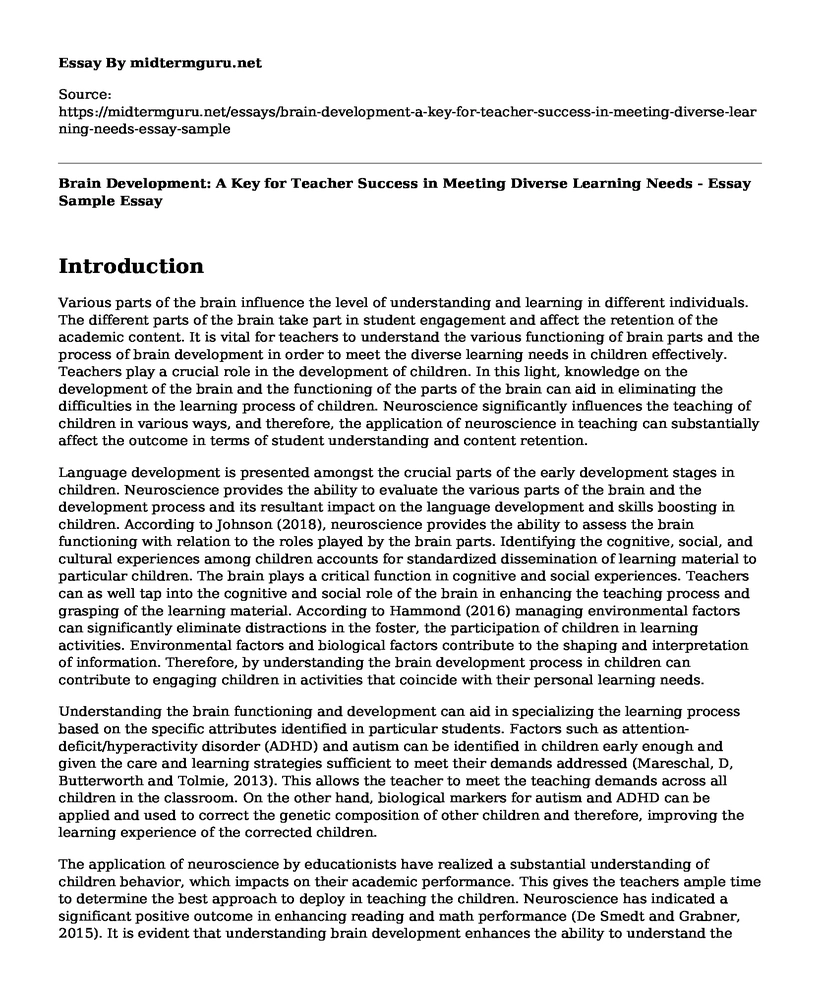Introduction
Various parts of the brain influence the level of understanding and learning in different individuals. The different parts of the brain take part in student engagement and affect the retention of the academic content. It is vital for teachers to understand the various functioning of brain parts and the process of brain development in order to meet the diverse learning needs in children effectively. Teachers play a crucial role in the development of children. In this light, knowledge on the development of the brain and the functioning of the parts of the brain can aid in eliminating the difficulties in the learning process of children. Neuroscience significantly influences the teaching of children in various ways, and therefore, the application of neuroscience in teaching can substantially affect the outcome in terms of student understanding and content retention.
Language development is presented amongst the crucial parts of the early development stages in children. Neuroscience provides the ability to evaluate the various parts of the brain and the development process and its resultant impact on the language development and skills boosting in children. According to Johnson (2018), neuroscience provides the ability to assess the brain functioning with relation to the roles played by the brain parts. Identifying the cognitive, social, and cultural experiences among children accounts for standardized dissemination of learning material to particular children. The brain plays a critical function in cognitive and social experiences. Teachers can as well tap into the cognitive and social role of the brain in enhancing the teaching process and grasping of the learning material. According to Hammond (2016) managing environmental factors can significantly eliminate distractions in the foster, the participation of children in learning activities. Environmental factors and biological factors contribute to the shaping and interpretation of information. Therefore, by understanding the brain development process in children can contribute to engaging children in activities that coincide with their personal learning needs.
Understanding the brain functioning and development can aid in specializing the learning process based on the specific attributes identified in particular students. Factors such as attention-deficit/hyperactivity disorder (ADHD) and autism can be identified in children early enough and given the care and learning strategies sufficient to meet their demands addressed (Mareschal, D, Butterworth and Tolmie, 2013). This allows the teacher to meet the teaching demands across all children in the classroom. On the other hand, biological markers for autism and ADHD can be applied and used to correct the genetic composition of other children and therefore, improving the learning experience of the corrected children.
The application of neuroscience by educationists have realized a substantial understanding of children behavior, which impacts on their academic performance. This gives the teachers ample time to determine the best approach to deploy in teaching the children. Neuroscience has indicated a significant positive outcome in enhancing reading and math performance (De Smedt and Grabner, 2015). It is evident that understanding brain development enhances the ability to understand the influence of the brain on language development. In this light, teachers can comprehend phonological awareness in children, which aid in breaking down words in simple ways that allow the children to pronounce and boost their reading skills. Memory is also fostered by use memorizing. Combining of games and learning has indicated a higher success rate, especially in boys' performance.
Conclusion
In conclusion, neuroscience aids teachers in identifying and addressing specific learning goals provide a wide range of approaches that meet students' demands and influence decision making as far as learning methods are concerned. Difficulties in certain areas are addressed with specialized learning goals. Therefore, teachers can meet the various needs of students and improving academic performance.
References
De Smedt, B. and Grabner, R.H., 2015. Applications of neuroscience to mathematics education. In The Oxford handbook of numerical cognition. DOI: 10.1093/oxfordhb/9780199642342.013.48
Hammond, C., 2016. Inside the Brain of a Five-Year-Old. BBC Radio 4 Extra. Available at: https://www.bbc.co.uk/programmes/b00rm072 [Accessed May 22, 2019].
Johnson, S., 2018. Brain Science and Education: How Much Should Teachers Know? - EdSurge News. EdSurge. Available at: https://www.edsurge.com/news/2016-12-20-brain-science-and-education-how-much-should-teachers-know [Accessed May 22, 2019].
Mareschal, D., Butterworth, B. and Tolmie, A. eds., 2013. Educational neuroscience. John Wiley & Sons.
Cite this page
Brain Development: A Key for Teacher Success in Meeting Diverse Learning Needs - Essay Sample. (2023, Jan 14). Retrieved from https://midtermguru.com/essays/brain-development-a-key-for-teacher-success-in-meeting-diverse-learning-needs-essay-sample
If you are the original author of this essay and no longer wish to have it published on the midtermguru.com website, please click below to request its removal:
- Studying Online: Coursera
- Relationship Based Care in Cultural and Historical Setting
- How Do I View the Purpose of College? Essay Example
- Essay Sample on Teacher Pay in North Carolina
- Essay Sample on Single Parenthood
- Rhetorical Analysis Essay: "Is There Pressure on Teenagers to Go to College?"
- Kids' Role-Play: Unlocking Creativity & Social Skills - Essay Sample







